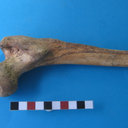Diffuse idiopathic skeletal hyperostosis in the Medici, Grand Dukes of Florence (XVI century).
Mots clés
Abstrait
Diffuse idiopathic skeletal hyperostosis (DISH) is a common systemic disorder characterised by the ossification of the anterior longitudinal spinal ligament involving at least three contiguous vertebrae and by diffuse extraspinal enthesopathies. The condition is associated with the male sex and with advanced age; its aetiology is uncertain, but seems to be related to obesity and diabetes. The most recent studies in archaeological series demonstrated a relation between high social status and the incidence of DISH. The present study examines two cases of DISH found amongst the members of the Medici family buried in the Basilica of San Lorenzo in Florence. The skeletons of the Grand Dukes Cosimo I (1519-1574) and his son Ferdinand I (1549-1609) showed the typical features of the condition. This result is related to the obesity of the Grand Dukes, attested by the written and artistic sources, and to the protein-based alimentation demonstrated by a paleonutritional study, thus furnishing further evidence to the significance of DISH as a life style.





